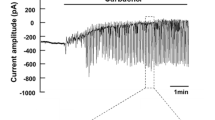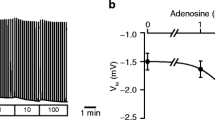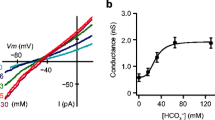Abstract.
A Ca2+-activated Cl− conductance in rat submandibular acinar cells was identified and characterized using whole-cell patch-clamp technique. When the cells were dialyzed with Cs-glutamate-rich pipette solutions containing 2 mm ATP and 1 μm free Ca2+ and bathed in N-methyl-d-glucamine chloride (NMDG-Cl) or Choline-Cl-rich solutions, they mainly exhibited slowly activating currents. Dialysis of the cells with pipette solutions containing 300 nm or less than 1 nm free Ca2+ strongly reduced the Cl− currents, indicating the currents were Ca2+-dependent. Relaxation analysis of the ``on'' currents of slowly activating currents suggested that the channels were voltage-dependent. The anion permeability sequence of the Cl− channels was: NO− 3 (2.00) > I− (1.85) ≥ Br− (1.69) > Cl− (1.00) > bicarbonate (0.77) ≥ acetate (0.70) > propionate (0.41) ≫ glutamate (0.09). When the ATP concentration in the pipette solutions was increased from 0 to 10 mm, the Ca2+-dependency of the Cl− current amplitude shifted to lower free Ca2+ concentrations by about two orders of magnitude. Cells dialyzed with a pipette solution (pCa = 6) containing ATP-γS (2 mm) exhibited currents of similar magnitude to those observed with the solution containing ATP (2 mm). The addition of the calmodulin inhibitors trifluoperazine (100 μm) or calmidazolium (25 μm) to the bath solution and the inclusion of KN-62 (1 μm), a specific inhibitor of calmodulin kinase, or staurosporin (10 nm), an inhibitor of protein kinase C to the pipette solution had little, if any, effect on the Ca2+-activated Cl− currents. This suggests that Ca2+/Calmodulin or calmodulin kinase II and protein kinase C are not involved in Ca2+-activated Cl− currents. The outward Cl− currents at +69 mV were inhibited by NPPB (100 μm), IAA-94 (100 μm), DIDS (0.03–1 mm), 9-AC (300 μm and 1 mm) and DPC (1 mm), whereas the inward currents at −101 mV were not. These results demonstrate the presence of a bicarbonate- and weak acid-permeable Cl− conductance controlled by cytosolic Ca2+ and ATP levels in rat submandibular acinar cells.
Similar content being viewed by others
Author information
Authors and Affiliations
Additional information
Received: 9 January 1996/Revised: 20 May 1996
Rights and permissions
About this article
Cite this article
Ishikawa, T. A Bicarbonate- and Weak Acid-permeable Chloride Conductance Controlled by Cytosolic Ca2+ and ATP in Rat Submandibular Acinar Cells. J. Membrane Biol. 153, 147–159 (1996). https://doi.org/10.1007/s002329900118
Issue Date:
DOI: https://doi.org/10.1007/s002329900118




